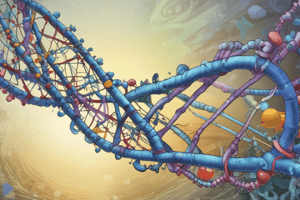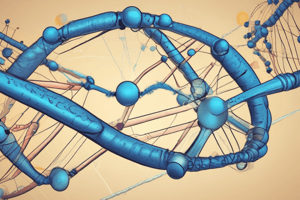Podcast
Questions and Answers
What is the purpose of using a fresh pipet tip for each suspect sample?
What is the purpose of using a fresh pipet tip for each suspect sample?
- To speed up the mixing process
- To prevent cross-contamination between samples (correct)
- To ensure consistency in sample volume
- To increase the temperature of the samples
What is the first step in the PCR reaction setup as described?
What is the first step in the PCR reaction setup as described?
- Place the samples in the thermocycler
- Cap the PCR tubes and place them on ice
- Add iQ SYBR Green Supermix to the PCR tubes (correct)
- Add loading dye to the PCR tubes
What should not be done when mixing samples with the pipet?
What should not be done when mixing samples with the pipet?
- Use the same pipet tip for multiple samples
- Cap the tube before mixing
- Press the plunger down past the first stop (correct)
- Mix the sample for too long
How long should the initial denaturing step last during the PCR process?
How long should the initial denaturing step last during the PCR process?
What is the temperature used for the annealing step during thermal cycling?
What is the temperature used for the annealing step during thermal cycling?
What should be recorded before placing the samples in the quantitative PCR thermocycler?
What should be recorded before placing the samples in the quantitative PCR thermocycler?
What is the purpose of pulse spinning the microcentrifuge tube after collecting PCR tubes from the thermocycler?
What is the purpose of pulse spinning the microcentrifuge tube after collecting PCR tubes from the thermocycler?
What should be done with the gel before loading samples in electrophoresis?
What should be done with the gel before loading samples in electrophoresis?
What is the primary purpose of PCR in forensic analysis?
What is the primary purpose of PCR in forensic analysis?
Why is it important to label the sides of the PCR tubes rather than the caps?
Why is it important to label the sides of the PCR tubes rather than the caps?
What role does DNA free water play in the PCR process?
What role does DNA free water play in the PCR process?
Which of the following materials is used for analyzing PCR products?
Which of the following materials is used for analyzing PCR products?
What steps should be taken to prevent contamination when preparing PCR samples?
What steps should be taken to prevent contamination when preparing PCR samples?
In the PCR process, what is the significance of using repeated cycles of temperature fluctuations?
In the PCR process, what is the significance of using repeated cycles of temperature fluctuations?
How many μL of Crime Scene DNA should be added to its respective PCR tube?
How many μL of Crime Scene DNA should be added to its respective PCR tube?
What is the primary function of the iQ SYBR Green Supermix in the PCR process?
What is the primary function of the iQ SYBR Green Supermix in the PCR process?
Flashcards are hidden until you start studying
Study Notes
PCR-Based Crime Scene Analysis
- This lab simulates crime scene analysis using PCR, a technique amplifying trace DNA amounts.
- Students will use the technique to generate and analyze mock crime scene samples, mimicking real-world forensic investigation.
- Materials:
- DNA Samples: Crime scene, four suspects (A-D), and DNA-free water for negative control
- PCR Reagents: iQ SYBR Green Supermix (MMP) - a reagent that fluoresces when bound to DNA, enabling real-time PCR analysis.
- Equipment: Micropipettes, pipette tips, PCR tubes, thermocycler, E-gel electrophoresis system with 1% Agarose Gel, and loading dye.
PCR Procedure
- Carefully label PCR tubes to avoid sample mix-up: NC (Negative Control), CS (Crime Scene), A (Suspect A), B,C, D, and a tube labeled with the group number. Ensure no labels are on the tube caps, which can interfere with fluorescence measurement.
- Sample Preparation: Add 12.5 μL of each DNA sample (Crime Scene and Suspects) to their respective labelled PCR tubes.
- Negative Control: Add 12.5 μL of DNA-free water to the NC tube.
- Master Mix Addition: Add 12.5 μL of iQ SYBR Green Supermix (MMP) to each tube, ensuring separate tips for each sample to prevent contamination.
- Thermocycling:
- Initial Denaturation: 94°C for 2 minutes, one cycle.
- Thermal Cycling: 35 cycles of:
- Denaturation: 94°C for 30 seconds.
- Annealing: 52°C for 30 seconds.
- Extension: 72°C for 1 minute.
- Melt Curve Analysis: 55°C to 95°C, heating at 0.5°C every 10 seconds for data measurement.
- Day 2 - Electrophoresis:
- Set up the electrophoresis unit and gels.
- Sample Preparation: Collect PCR tubes, pulse spin to collect liquid, and dilute each sample as instructed.
- Loading: Add 1 μL of loading dye to each sample.
- Gel Loading: Carefully load 20 μL of each sample onto the prepared gel.
Understanding Lab Results
- Students analyze their PCR results by comparing DNA profiles generated from the crime scene sample to the suspects.
- This might involve matching specific DNA bands or patterns to determine which suspect's DNA matches the crime scene sample.
- Results and their interpretation are crucial components of the lab report.
Studying That Suits You
Use AI to generate personalized quizzes and flashcards to suit your learning preferences.




